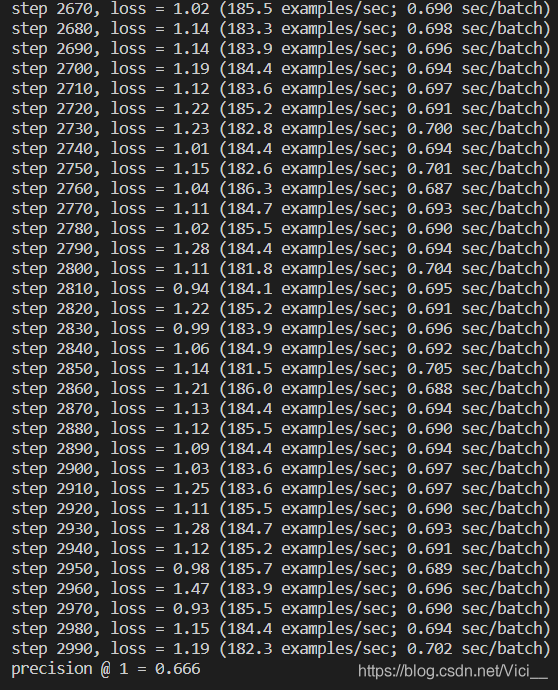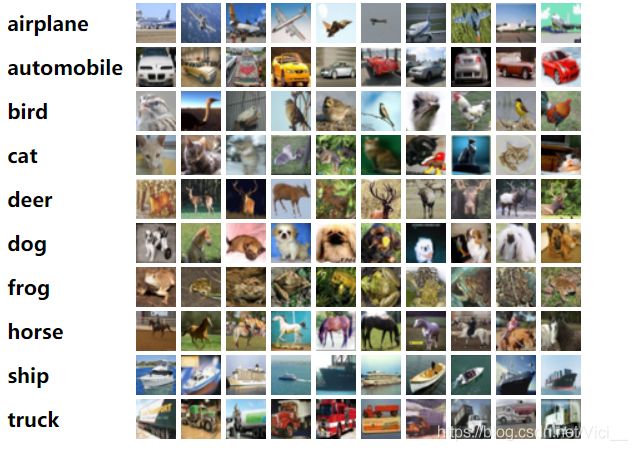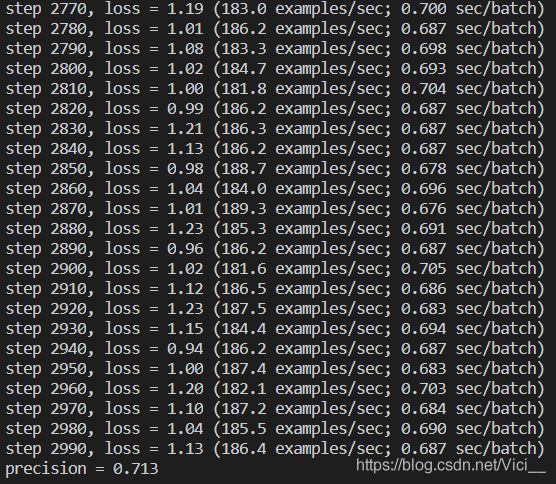【图像识别】CIFAR-10(CNN)
一、CIFAR-10简介
CIFAR-10官网
CIFAR-10 是由 Hinton的学生Alex Krizhevsky和 Ilya Sutskever 整理的一个用于识别普适物体的小型数据集。
它一共包含10个类别的RGB彩色图片,具体参考如下图:数据集中一共有5000张训练图片和1000张测试图片,图片的尺寸大小为 32 * 32。
官方提供文件介绍:
文件 用途 cifar10.py 建立 CIFAR-10 预测模型 cifar10_input.py 在 TensorFlow 中读入 CIFAR-10 文件 cifar10_input_test.py cifar10_input.py 的测试用例文件 cifar10_train.py 使用单个GPU或CPU训练模型 cifar10_train_multi_gpu.py 使用多个GPU训练模型 cifar10_eval.py 在测试集上测试模型的性能 - cifar10.py 文件中的 inference(images) 函数是官方提供的模型。
二、CIFAR-10 和 MNIST数据集的区别
CIFAR-10 MNIST 图像通道数 3 通道的 RGB 图像 灰度图像 尺寸大小 32 × 32 28 × 28 图片内容 现实世界的真实物体 0 ~ 9 数字 图片特点 噪声很大,可能有背景图片或其他物体干扰;
物体的比例、特征都不尽相同,识别难度大噪声小,干扰物体少;
易识别
三、参考官方代码编写CNN模型
import tensorflow as tf import numpy as np import time import math # 官方提供的两个文件,用于对数据集的输入等操作 import cifar10 import cifar10_input max_steps = 3000 # 训练次数 batch_size = 128 # 批处理参数 # ---1.加载数据 --- # 下载cifar10数据集的默认路径,需要把cifar10.py/line 53/对应代码改一下 data_dir = 'D:/Python_code/Data/cifar-10-python/cifar-10-batches-bin' # 权值初始化函数(shape,标准差,L2正则化比例系数) def variable_with_weight_losses(shape, stddev, wl): # 使用tf.truncated_normal截断的正态分布来初始化 var = tf.Variable(tf.truncated_normal(shape, stddev=stddev)) if wl is not None: # 做一个L2的正则化处理,用wl控制L2的大小比例 weight_loss = tf.multiply(tf.nn.l2_loss(var), wl, name='weight_loss') # 将weight_loss统一存放起来 tf.add_to_collection("losses", weight_loss) return var # 调用cifar10.py中的一个函数,下载数据集,并解压 cifar10.maybe_download_and_extract() # 生成训练数据,使用distorted_inputs函数,做数据增强处理 images_train, labels_train = cifar10_input.distorted_inputs(data_dir=data_dir, batch_size=batch_size) # 生成测试数据,不必做数据增强 images_test, labels_test = cifar10_input.inputs(eval_data=True, data_dir=data_dir, batch_size=batch_size) # 占位符 image_holder = tf.placeholder(tf.float32, [batch_size, 24, 24, 3]) label_holder = tf.placeholder(tf.int32, [batch_size]) # ---2. 构建模型 --- # 第一层卷积层,64个卷积核,大小为5*5,3通道(RGB三种颜色通道) # 1).定义权重 weight1 = variable_with_weight_losses(shape=[5,5,3,64], stddev=0.05, wl=0.0) # 2).卷积操作 kernel1 = tf.nn.conv2d(image_holder, filter=weight1, strides=[1, 1, 1, 1], padding='SAME') # 3).定义偏差 bias1 = tf.Variable(tf.constant(0.0, shape=[64])) # 4).relu激活函数 conv1 = tf.nn.relu(tf.nn.bias_add(kernel1, bias1)) # 5).最大池化 pool1 = tf.nn.max_pool(conv1, ksize=[1, 3, 3, 1], strides=[1, 2, 2, 1], padding='SAME') # 6.lrn: 局部响应归一化,可防止过拟合,原理是生物学上的‘侧抑制’,(通俗来讲就是增强强的地方,削弱弱的地方) # pool1表示输入数据,4表示使用前后几层进行归一化操作,bias表示偏移量,alpha和beta表示系数 norm1 = tf.nn.lrn(pool1, 4, bias=1.0, alpha=0.001/9.0, beta=0.75) # 第二层卷积层 weight2 = variable_with_weight_losses(shape=[5,5,64,64], stddev=5e-2, wl=0.0) kernel2 = tf.nn.conv2d(norm1, filter=weight2, strides=[1, 1, 1, 1], padding='SAME') bias2 = tf.Variable(tf.constant(0.1, shape=[64])) conv2 = tf.nn.relu(tf.nn.bias_add(kernel2, bias2)) norm2 = tf.nn.lrn(conv2, 4, bias=1.0, alpha=0.001/9.0, beta=0.75) pool2 = tf.nn.max_pool(norm2, ksize=[1, 3, 3, 1], strides=[1, 2, 2, 1], padding='SAME') # 第三层全连接层 # 将第二层卷积层输出结果变成一维向量 reshape = tf.reshape(pool2, [batch_size, -1]) dim = reshape.get_shape()[1].value # 初始化权值,隐含节点384个,正态分布标准差为0.04,偏差bias为0.1 weight3 = variable_with_weight_losses(shape=[dim,384], stddev=0.04, wl=0.004) bias3 = tf.Variable(tf.constant(0.1, shape=[384])) local3 = tf.nn.relu(tf.matmul(reshape, weight3) + bias3) # 第四层全连接层 weight4 = variable_with_weight_losses(shape=[384,192], stddev=0.04, wl=0.004) bias4 = tf.Variable(tf.constant(0.1, shape=[192])) local4 = tf.nn.relu(tf.matmul(local3, weight4) + bias4) # 第五层输出层 weight5 = variable_with_weight_losses(shape=[192,10], stddev=1/192.0, wl=0.0) bias5 = tf.Variable(tf.constant(0.0, shape=[10])) logits = tf.add(tf.matmul(local4, weight5), bias5) # 定义损失函数 def loss(logits, labels): labels = tf.cast(labels, tf.int64) # 交叉熵损失函数 cross_entropy = tf.reduce_mean(tf.nn.sparse_softmax_cross_entropy_with_logits( logits=logits, labels=labels )) tf.add_to_collection('losses', cross_entropy) return tf.add_n(tf.get_collection('losses'), name='total_loss') loss = loss(logits=logits,labels=label_holder) train_op = tf.train.AdamOptimizer(0.001).minimize(loss) top_k_op = tf.nn.in_top_k(logits, label_holder, 1) # ---3. 训练模型--- sess = tf.InteractiveSession() tf.global_variables_initializer().run() # 引入多线程 tf.train.start_queue_runners() for step in range(max_steps): start_time = time.time() image_batch, label_batch = sess.run([images_train, labels_train]) _, loss_value = sess.run([train_op, loss], feed_dict={image_holder: image_batch, label_holder: label_batch}) duration = time.time() - start_time if step % 10 == 0: examples_per_sec = batch_size / duration sec_per_batch = float(duration) str = 'step %d, loss = %.2f (%.1f examples/sec; %.3f sec/batch)' #print(step, loss_value) print(str % (step, loss_value, examples_per_sec, sec_per_batch)) num_examples = 10000 num_iter = int(math.ceil(num_examples / batch_size)) true_count = 0 total_sample_count = num_iter * batch_size step = 0 while step < num_iter: image_batch, label_batch = sess.run([images_test, labels_test]) predictions = sess.run([top_k_op], feed_dict={image_holder: image_batch, label_holder: label_batch}) true_count += np.sum(predictions) step += 1 precision = true_count / total_sample_count print('precision = %.3f' % precision)
四、训练结果
左图是基于 MNIST 采用 RMSProp 算法的优化器;
右图是参考书籍采用 Adam 优化器。
测试次数都是3000次。

参考文献:
- 《21个项目玩转深度学习》何之源
- bilibili - CNN识别图片
- CIFAR 官网

